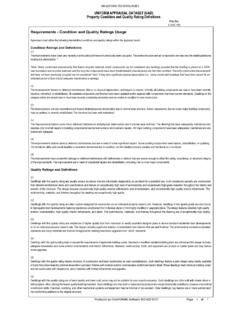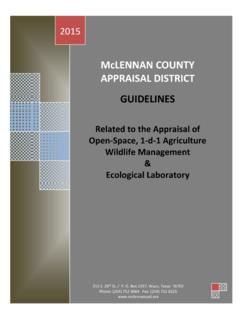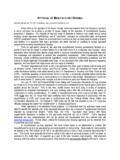Transcription of Appraisal Methods - oregon.gov
1 Appraisal MethodsBasic information and procedures for setting up a mass Appraisal program150-303-415 (Rev. 05-17)150-303-415 (Rev. 05-17) Appraisal Methods for Real property Table of contentsChapter Title Pages Foreword 1 Introduction to the property Tax System ..1 1 2 Organization and Administration ..2 1 3 Records ..3 1 4 oregon Cadastral Map System ..4 1 5 Fundamental Appraisal Concepts ..5 1 6 The Three Approaches to Value ..6 1 7 Statistics and Appraisal Standards ..7 1 8 Mass Appraisal of Land ..8 1 9 Mass Appraisal of Residential Properties ..9 1 10 Mass Appraisal of Income Producing Properties ..10 1 11 Mass Appraisal of Farm and Ranch Properties ..11 1 12 Common Ownership Properties.
2 12 1 13 Maximum Assessed and Assessed Value ..13 1 14 Other Assessment Programs ..14 1 15 property Tax Appeals ..15 1 16 Glossar y ..16 1 17 Index ..17 1150-303-415 (Rev. 05-17) Appraisal Methods for Real property ForewordAppraisal Methods for Real PropertyThis manual provides county assessors and their staffs with the basic information and procedures to set up and maintain a mass Appraisal program for property tax purposes . A well-run Appraisal program benefits and serves all those who pay property taxes in oregon .The International Association of Assessing Officers defines mass Appraisal as: .. the systematic Appraisal of groups of properties as of a given date using standardized procedures and statistical testing. By following the guidelines in this manual, it is possible to achieve accurate, persuasive, and defendable appraisals to use as the basis for property tax assessment.
3 The cost of estimating property value using other Methods would be prohibitive and not in the best interest of the public . This manual reflects laws and Department of Revenue policies that were current at the time of publication . In addition to other publications, we have utilized the following sources to produce this manual: property Assessment Valuation, Third Edition, IAAO, 2010 The Appraisal of Real Estate, 14th Edition, The Appraisal Institute, 2013 The Dictionary of Real Estate Appraisal , Sixth Edition, The Appraisal Institute, 2015 Note: Although this manual reflects laws and policies that were current as of the revision date, a substantial number of the forms and examples included in the manual haven t been updated since the time of the last major revision in 2003.
4 Be assured this doesn t invalidate the manual as an effective training tool for appraisers in the assessment field. 150-303-415 (Rev. 05-17) Appraisal Methods for Real property Chapter 1 Introduction to the property Tax SystemOregon s property tax system supplies revenue that funds services provided to citizens . In recent years, oregon voters approved two significant property tax limitations, yet revenue generated by property tax is second only to personal income tax revenue . For the 2014 15 tax year, property taxes raised more than $5 .7 billion for local governments .This chapter summarizes the assessment program and tax collection process .Legal basis for assessmentORS 307 .030 states: All real property within this state and all tangible personal property situated within this state, except as otherwise provided by law, shall be subject to assessment and taxation in equal and ratable proportion.
5 Except as provided in ORS 308 .505 to 308 .681, intangible personal property isn t subject to assessment and taxation . oregon has an ad valorem taxation system . The taxation system is based on the value of property . The amount of property tax an owner of a property will pay is determined by: The taxable assessed value of the property ; The total of the tax levies imposed by the taxing districts in which the property is located; and Constitutional tax limitations .Imposition of taxA taxing district collects property tax dollars by imposing a levy . property tax levies are either rate-based or amount-based . Most taxing districts impose rate-based levies for at least some of their operating revenues . The rate for most districts is limited by an amendment to oregon s constitution referred to as the permanent rate limit.
6 Districts can levy a tax rate every year that is less than or equal to this limit without additional voter approval . Amount-based levies are usually bond levies or local option levies that have been approved by the voters of a taxing district for a fixed dollar amount per year . Bond and local option levies are in addition to the permanent rate levy . Local option levies can be either rate-based or amount-based . When a taxing district imposes an amount-based levy, the county assessor converts the amount levied into a tax rate by dividing the levy amount by the total assessed value in the district . Role of the Department of RevenueThe Department of Revenue supervises the administration of the property tax system in oregon . ORS 306 .115 states: The department may do any act or give any order to any public officer or employee that the department deems necessary in the administration of the property tax laws so that all properties are taxed or are exempted from taxation according to the statutes and Constitutions of the State of oregon and of the United States.
7 In partnership with the counties, we: Train and provide technical assistance for county staff; Write administrative rules and legislative concepts; Advise the counties regarding property tax issues; Review the assessors certified ratio studies; Hold property tax supervisory and merits conferences; and Respond to questions from taxpayers . 1-1150-303-415 (Rev. 05-17) Appraisal Methods for Real property We are responsible for appraising and maintaining the inventory of large industrial improvements valued at over $1 million . The inventory of state appraised industrial property is updated annually through the state s Industrial property Return, 150-301-032 . The property that must be reported on the return includes buildings and structures, yard improvements, machinery and equipment, and personal property .
8 The department is also responsible for appraising and developing the inventory of all centrally assessed property . Centrally assessed property includes utility property , railroads, and airlines .Summary of the assessment programThe assessment program is the foundation of the property tax system in oregon . Each county has an elected or appointed assessor who administers the program at the local level . The assessor has the responsibility to discover, list, and value both real and taxable personal property according to the following guidelines .Assessment dateORS 308 .210(1) describes the assessment date and states in part:The assessor shall maintain a full and complete record of the assessment of the taxable property for each year as of January 1, at 1:00 a .m .Frequency of appraisalFrom 1955 to 1996, the assessor was required by law to physically reappraise all property in the county every six years.
9 This requirement was eliminated in 1997 for various reasons including budget constraints, accelerated Appraisal techniques, and the successful application of computerized valuation programs . Current law requires that each parcel of real property be appraised using a method of Appraisal approved by our administrative rule . See ORS 308 .234 .Duties of assessorThe major duties of the county assessor are: Locate and identify each property . Inventory each property . Classify each property . Estimate the real market value (RMV) of each property . Calculate the taxable value of each property . Prepare and certify the assessment roll for the county . Calculate the tax due for each property . Respond to all property value appeals .Locate and identify each propertyTo locate and identify property , the assessor needs an adequate mapping system that shows each parcel of land in the county.
10 After the assessor receives notice of the existence of new property , the assessor must describe the property to make an assessment . This is achieved through a parcel numbering system, referred to as cadastral mapping, in which each property is assigned its own identifier . (See Chapter 4 for more details .)1-2150-303-415 (Rev. 05-17) Appraisal Methods for Real property Inventory each propertyExcept for large industrial and utility property , the assessor is responsible for maintaining the inventory of land, buildings, and other improvements attached to the land throughout the county . Maintaining the inventory of real property requires an on-site inspection . During the inspection, the appraiser records the following information about the land and improvements: Size; Quality; Condition; and Other pertinent data.












